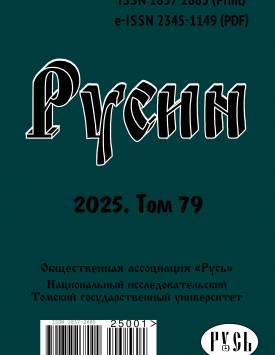Types of bilingualism in asymmetric language situations in Uzbekistan and Tajikistan
This article examines the types of bilingualism emerging in asymmetric language situations in Urgench (Republic of Uzbekistan) and Dushanbe (Republic of Tajikistan). The study adopts a broad interdisciplinary perspective, integrating linguistic, social, and psychological dimensions of bilingualism. Particular attention is paid to the age of second language acquisition (early and late bilingualism), as well as various functional types of ianguage use - coordinate and subordinate, active and passive, additive and subtractive bilingualism. The mechanisms of bilingualism formation are examined in the context of asymmetricai ianguage statuses and the functionai distribution of ianguages across institutional and personal discourses. The findings demonstrate that both the age of second ianguage acquisition and the sociocuiturai context determine not oniy the ievei of ianguage competence but aiso the type of bilingualism and the dynamics of ianguage interaction in individuai and group communication. The study emphasizes the importance of a comprehensive approach to the typoiogization of bilingualism, taking into account socioiinguistic and cognitive factors, and highiights the reievance of shifting from binary to continuum-based models of bilingualism classification for muitiiinguai regions.
Keywords
late bilingualism,
coordinate and subordinate bilingualism,
active and passive bilingualism,
additive and subtractive bilingualism,
Uzbek-Russian bilingualism,
Tajik-Russian bilingualismAuthors
| Dibrova Veronika S. | Tomsk State University | klobukova-veronika@list.ru |
Всего: 1
References
Aminov K., Jensen V., Juraev S. et al. Language Use and Language Policy in Central Asia // Central Asia Regional Data Review. 2010. Vol. 2, № 1. Р 1-29.
Anderson R. Language attrition in progress: Language acquisition and language loss. Groos, 1982. 272 p.
Benmamoun E., Montrul S., Polinsky M. Heritage languages and their speakers: Challenges and opportunities // Linguistic Approaches to Bilingualism. 2013. Vol. 3, № 1. Р 1-40. doi: 10.1515/lab-2013-0001.
Bialystok E. Bilingualism in Development: Language, Literacy, and Cognition. Cambridge: Cambridge University Press, 2001. 288 p. doi: 10.1017/ CBO9780511605963.
Bourdieu P Language and Symbolic Power. Cambridge: Harvard University Press, 1991. 302 p.
Fishman J.A. Bilingualism with and without diglossia // Journal of Social Issues. 1967. Vol. 23, № 2. Р 29-38. doi: 10.1111/j.1540-4560.1967.tb00573.x.
Gardner R.C. Social Psychology and Second Language Learning: The Role of Attitudes and Motivation. London: Edward Arnold, 1985. 208 p.
Giles H., Johnson P. Ethno-Linguistic identity theory: A social psychological approach to language maintenance // International Journal of the Sociology of Language. 1987. Vol. 68. Р 69-100. doi: 10.1515/ijsl.1987.68.69.
Grichkovtsova I. Bilingual Minds: Emotional Experience, Expression and Representation, Aneta Pavlenko (Ed.) // Studies in Second Language Acquisition. 2007. Vol. 29, № 4. Р 625-627. doi: 10.1017/S0272263100007634.
Herdina P.,Jessner U. Dynamic systems theory and multilingualism // The Cambridge Handbook of Language Learning / ed. by J.W. Schwieter. Cambridge: Cambridge University Press, 2023. Р 145-168. doi: 10.21832/9781853598746.
Lambert W.E. Culture and language as factors in learning and education // Cultural Diversity and Canadian Education: Issues and Innovations / eds. by J. Mallea, J. Young. Montreal: McGill-Queen's University Press, 1984. Р 91-122.
Marian V., Blumenfeld H.K., Kaushanskaya M. Language Experience and Proficiency Questionnaire (LEAP-O) // Speech, Language, and Hearing Research. 2007. Vol. 50, № 4. P 940-967. URL: http://www.bilingualism.northwestern.edu/leapq (дата обращения: 29.09.2022).
McLaughlin B. Second-Language Acquisition in Childhood. Vol. 1: Preschool Children. Hillsdale: Lawrence Erlbaum Associates, 1984. 317 p.
Meisel J.M. The bilingual child // The Handbook of Bilingualism, 2006. Р 90-113. doi: 10.1017/CB09780511611780.003.
Spolsky B. Language Policy. Cambridge: Cambridge University Press, 2004. 262 p.
Valdes G. Heritage language students: Profiles and possibilities // Heritage Languages in America: Preserving a National Resource / eds. by J.K. Peyton, D.A. Ranard, S. McGinnis. Washington: Center for Applied Linguistics, 2001. Р 37-77.
Казакевич О.А. Документация исчезающих языков Сибири (на материале двух поселков Красноярского края) // Вестник Российского гуманитарного научного фонда. 2006. № 3 (44). С. 221-231.
Першуткина С.П., Макушин М.А., Федорко В.Н. Русский язык в геокультурном пространстве Узбекистана: факторы, тенденции, территориальные и социальные особенности развития // Центральноазиатский журнал географических исследований. 2022. № 1-2. С. 61-76.

